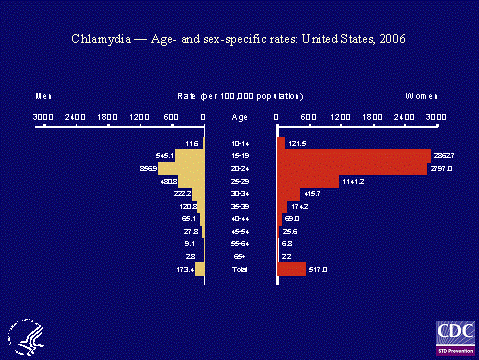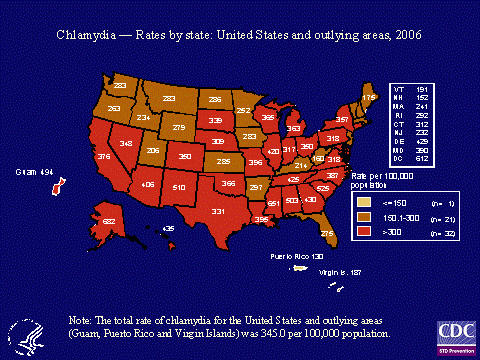CDC Features
Current Features
STD Awareness Month

STDs are a major public health issue in the United States:
• The Centers for Disease Control and Prevention (CDC) estimates that there are approximately 19 million new cases of STDs each year, almost half of them among young people ages 15 to 24.1
• STDs have an economic impact: direct medical costs associated with STDs in the U.S. are estimated at $15.3 billion annually.2
• There are physical and psychological impacts. Untreated, some STDs can lead to serious health consequences, including infertility.
Many of those who are infected don't know it. Many STDs do not have any symptoms. The only way to know for sure whether you have an STD is to get tested.
Chlamydia Rates
Chlamydia remains the most commonly reported infectious disease in the United States. In 2006, 1,030,911 chlamydia diagnoses were reported, up from 976,445 in 2005. Even so, most chlamydia cases go undiagnosed. It is estimated that there are approximately 2.8 million new cases of chlamydia in the United States each year. 1
Women, especially young women, are hit hardest by chlamydia. Studies have found that chlamydia is more common among adolescent females than adolescent males, and the long-term consequences of untreated disease are much more severe for females. The chlamydia case rate for females in 2006 was three times higher than for males.
Importance of Screening
Because chlamydia is most common among young women, CDC recommends annual chlamydia screening for all sexually active women under age 26, as well as older women with risk factors such as new or multiple sex partners.3 Data from one study in a managed care setting suggest that chlamydia screening and treatment can reduce the incidence of pelvic inflammatory disease (PID) by over 50 percent.4 Unfortunately, many sexually active young women are not being tested for chlamydia, in part reflecting a lack of awareness among some providers and limited resources for screening.5 Research has shown that simple changes in clinical procedures, such as coupling chlamydia tests with routine pap testing, can sharply increase the proportion of sexually active young women screened.6 Increased prevention screening efforts are critical to preventing the serious health consequences of this infection, particularly infertility.
To learn more about STDs, STD Awareness Month, and where you can find the nearest STD testing site in your area please visit
• CDC STD Prevention Home Page
Citations
1. Weinstock H, et al. Sexually transmitted diseases among American youth: incidence and prevalence estimates, 2000. Perspectives on Sexual and Reproductive Health 2004;36( 1):6-10.
2. HW Chesson, JM Blandford, TL Gift, G Tao, KL Irwin. The estimated direct medical cost of STDs among American youth, 2000. 2004 National STD Prevention Conference. Philadelphia, PA. March 8–11, 2004. Abstract P075.
3. CDC. Sexually transmitted diseases treatment guidelines, 2006. Morbidity and Mortality Weekly Report 2006;55(RR-11).
4. Scholes D, Stergachis A, Heidrich FE, Andrilla H, Holmes KK, Stamm WE. Prevention of pelvic inflammatory disease by screening for cervical chlamydial infection. New England Journal of Medicine 1996;334(21 ):1362-1366.
5. National Committee for Quality Assurance. The State of Health Care Quality 2006. Washington, D.C., 2006:30, 57-67.
6. Burstein G, Snyder M, Conley D, Newman DR, Walsh CM, Tao G, Irwin KL. Chlamydia screening in a health plan before and after a national performance measure introduction. Obstetrics & Gynecology 2005; 106(2):327-334.
Page last updated: April 7, 2008
Content source: National Center for HIV/AIDS, Viral Hepatitis, STD, and TB Prevention
Content owner: National Center for Health Marketing
URL for this page: www.cdc.gov/Features/STDAwareness



